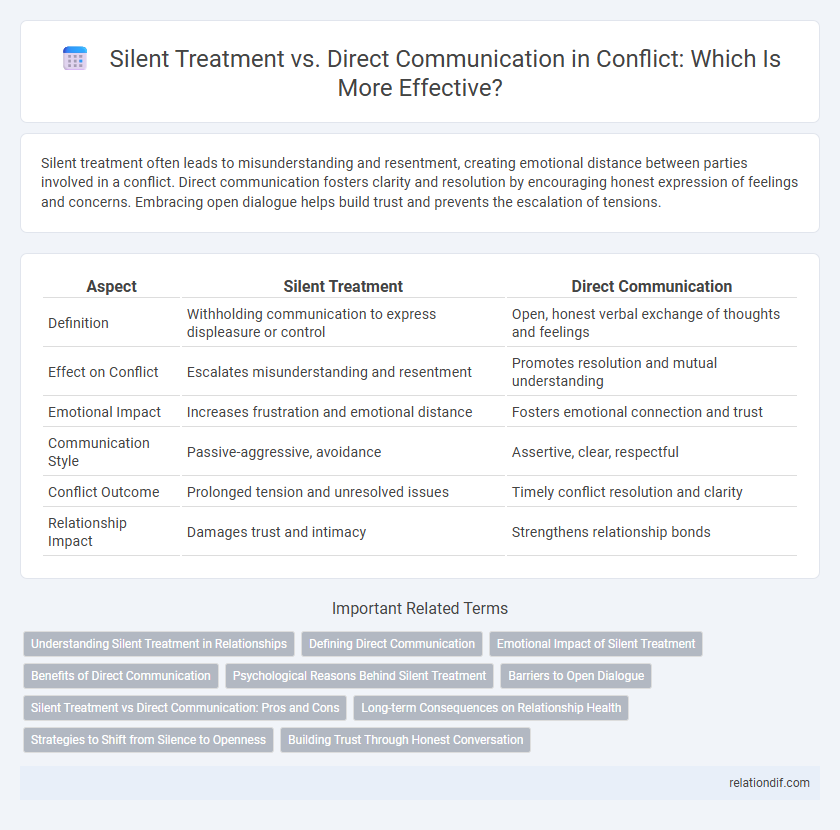Silent treatment often leads to misunderstanding and resentment, creating emotional distance between parties involved in a conflict. Direct communication fosters clarity and resolution by encouraging honest expression of feelings and concerns. Embracing open dialogue helps build trust and prevents the escalation of tensions.
Table of Comparison
| Aspect | Silent Treatment | Direct Communication |
|---|---|---|
| Definition | Withholding communication to express displeasure or control | Open, honest verbal exchange of thoughts and feelings |
| Effect on Conflict | Escalates misunderstanding and resentment | Promotes resolution and mutual understanding |
| Emotional Impact | Increases frustration and emotional distance | Fosters emotional connection and trust |
| Communication Style | Passive-aggressive, avoidance | Assertive, clear, respectful |
| Conflict Outcome | Prolonged tension and unresolved issues | Timely conflict resolution and clarity |
| Relationship Impact | Damages trust and intimacy | Strengthens relationship bonds |
Understanding Silent Treatment in Relationships
Silent treatment in relationships often serves as a non-verbal expression of frustration or anger, creating emotional distance that hinders effective communication. Recognizing this behavior is crucial for addressing underlying issues, as prolonged silence can escalate conflicts and damage trust. Implementing direct communication strategies promotes clarity and emotional connection, reducing misunderstandings and fostering healthier conflict resolution.
Defining Direct Communication
Direct communication involves expressing thoughts and feelings openly and honestly, promoting clarity and minimizing misunderstandings in conflict situations. This approach encourages active listening, assertiveness, and constructive dialogue to resolve disagreements effectively. Unlike the silent treatment, direct communication fosters trust and mutual respect by addressing issues head-on.
Emotional Impact of Silent Treatment
The silent treatment generates feelings of isolation, anxiety, and confusion, deeply affecting emotional well-being by fostering uncertainty and mistrust. Unlike direct communication, which encourages resolution and understanding, silent treatment prolongs conflict and intensifies emotional distress. Its passive-aggressive nature often leads to decreased self-esteem and increased frustration in relationships.
Benefits of Direct Communication
Direct communication enhances conflict resolution by fostering clear understanding and reducing misinterpretations. It builds trust and strengthens relationships through honest expression of feelings and concerns. This approach accelerates problem-solving by addressing issues promptly and collaboratively.
Psychological Reasons Behind Silent Treatment
The silent treatment is often a psychological defense mechanism rooted in fear of confrontation, desire for control, or emotional overwhelm, which can exacerbate conflict by fostering misunderstanding and resentment. In contrast, direct communication enables individuals to express feelings openly, promoting resolution and emotional clarity. Understanding these psychological motivations can help in addressing the underlying issues and encouraging healthier conflict management strategies.
Barriers to Open Dialogue
Silent treatment acts as a significant barrier to open dialogue by creating emotional distance and fostering misunderstanding between parties. This form of communication avoidance often leads to unresolved issues and escalating tension in conflicts. Direct communication, by contrast, enables clear expression of feelings and needs, facilitating resolution and mutual understanding.
Silent Treatment vs Direct Communication: Pros and Cons
Silent treatment during conflict tends to create emotional distance and prolong resentment, often leading to misunderstandings and reduced relationship satisfaction. Direct communication facilitates clarity and resolution by encouraging open expression of feelings and needs, yet it can sometimes escalate tensions if not handled carefully. Understanding when to use silence or speech strategically helps manage conflicts more effectively by balancing emotional space with honest dialogue.
Long-term Consequences on Relationship Health
Silent treatment fosters resentment and erodes trust by creating emotional distance, often leading to prolonged misunderstandings and decreased intimacy. In contrast, direct communication encourages openness and resolution, strengthening emotional bonds and promoting mutual understanding. Over time, consistent direct dialogue builds a resilient relationship, while persistent silent treatment risks chronic dissatisfaction and eventual breakdown.
Strategies to Shift from Silence to Openness
Implementing strategies such as expressing feelings through "I" statements, scheduling calm and intentional conversations, and practicing active listening helps shift from silent treatment to open dialogue. Encouraging vulnerability while setting clear boundaries fosters trust and reduces misunderstandings in conflict resolution. Creating a safe environment where both parties feel heard accelerates the transition from silence to constructive communication.
Building Trust Through Honest Conversation
Silent treatment undermines trust by creating emotional distance and breeding misunderstandings, whereas direct communication fosters transparency and mutual respect. Engaging in honest conversations allows parties to express feelings openly, address issues promptly, and build a foundation of reliability. Consistent, clear dialogue enhances trust, preventing resentment and promoting healthier conflict resolution.
silent treatment vs direct communication Infographic

 relationdif.com
relationdif.com